Archives
Download PDFs of past issues.
2025
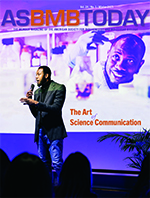 Winter
Winter
In this issue, we look at ten years of the Art of Science Communication, the ASBMB course that helps scientists explain their work to diverse audiences, and we share essays about some of the ways scientists communicate. We also profile the ten winners of ASBMB’s 2025 awards.
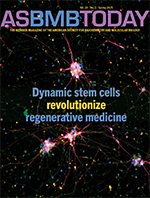 Spring
Spring
In this issue, we examine the inner workings of induced pluripotent stem cells and how they are being used to treat diabetes, spinal cord injury, stroke and more. We also feature a collection of essays on being neurodivergent in science.
 Summer
Summer
In this issue, we spotlight groundbreaking rare disease research — including innovative therapies for prion and Lafora diseases and treatments targeting chromosome 15 disorders. We also showcase new trends in undergraduate education and address the role of AI in the classroom.
 Fall
Fall
In this issue, we explore how artificial intelligence can power the future of biochemistry and molecular biology. Hear from ASBMB members on how they are using AI in their teaching and research.
2024
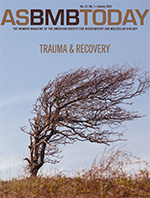 January
January
In this issue we focus on trauma and recovery with essays by ASBMB members about surviving some of the toughest challenges life can throw at a person — and advice for getting yourself and others through the bad times. We also offer profiles of our 2024 award winners.
 April
April
In this issue, we feature labs that are working to save corals from the effects of climate change, a deep dive into the recently approved CRISPR–Cas 9 therapy for sickle cell disease, an introduction to our 2024 ASBMB fellows and much more.
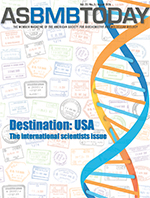 August
August
In this issue, we tell stories of biochemists who come the U.S. from other countries to study and pursue research. We look at visa challenges, the ASBMB PROLAB program and the “China initiative.”
2023
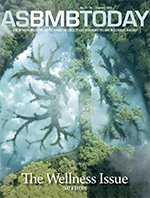 January
January
In our 2023 wellness issue, we invite you to take a breath and take care of yourself. We include a feature about the connection between breathing and the brain, a Q&A on the intersectionality of race and mental health, and other articles and essays focused on wellness.
 February
February
To mark Black History Month, we look at how the MOSAIC program is changing the landscape for postdocs with goals of diversity, equity and inclusion, and we share the story of a scientist who wasn't an ASBMB member but should have been.
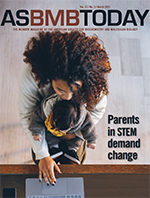 March
March
This month, ASBMB Advocacy Training Program participants describe how they’re putting their new skills to work, Namandjé Bumpus tells us about being chief scientist of the U.S. Food and Drug Administration and we hear about the challenges of being a parent and a scientist.
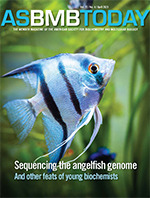 April
April
This month we focus on very early-career scientists, including high schoolers who work with macromolecule models, undergrads doing research on everything from cockroaches to pineapple juice and a teenager who sequenced a genome.
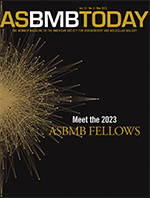 May
May
In this issue, meet the 20 members who have been named the ASBMB's 2023 fellows, and read thoughtful essays by five of our 2022 fellows on what engagement with the society has meant to them. Also, meet Brian Strahl, a Journal of Biochemistry associate editor.
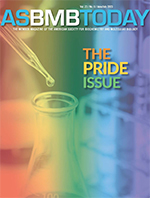 June/July
June/July
In our first Pride issue, we take a look at how new state laws are changing the landscape for LGBTQIA+ scientists and share a dozen stories from biochemists and others in the LGBTQIA+ community.
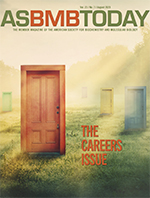 August
August
In our annual careers issue, we offer essays and articles on writing, teaching, careers outside the academic lab, unpromotable work and more.
 September
September
This month we look at how noninvasive biopsies use proteomics and bodily fluids to test for everything from kidney cancer to anxiety. Also, meet the co-chairs of Discover BMB 2024 and see how college students in Pakistan created a wall map of metabolic pathways.
 October
October
This month we kick off coverage of Discover BMB 2024, our annual meeting in San Antonio, with an announcement of our award winners, articles by symposia organizers and more. Plus, read about how the pandemic accelerated innovation in the classroom and about two ASBMB-funded outreach projects.
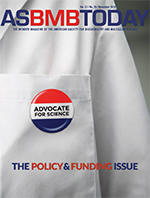 November
November
In this month's issue, we look at science policy and funding, including a feature about the ASBMB’s own Advocacy Training Program, interviews with officials and information about programs to fund scientists at multiple career levels. Also, our members in San Antonio tell us what's wonderful about their city.
 December
December
This month we take a deep dive into Katalin Karikó and Drew Weissman's 2023 Nobel Prize for their work on mRNA vaccines. We also meet JBC associate editor Robert Haltiwanger, consider the latest White House memo on scientific publishing and share our annual gift guide.
2022
 January
January
In our annual issue dedicated to wellness, contributors told personal stories about paddleboarding, skating, dancing, drumming, playing with and training their pets, and making things with their bare hands, among others.
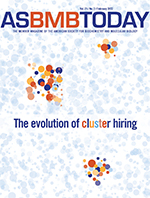 February
February
This month, writer Laurel Oldach takes a look at cluster hiring — a mechanism originally designed to assemble research teams that is now being used as a tool to increase diversity. Also in this issue, the story of the first Black man to hold a tenured academic appointment at Washington University School of Medicine.
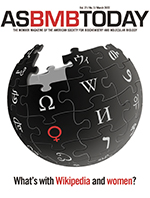 March
March
For Women’s History Month, our cover story is about how things are changing, slowly but surely, when it comes to entries about women in Wikipedia. Also within: essays by women on their invisible labor and the pandemic’s effects on their careers and connections.
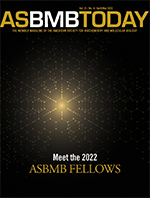 April/May
April/May
This month, we introduce the ASBMB’s 2022 fellows, 28 members who have “contributed to the core missions of the society.” We also offer a deep dive into the scramble for protein nanopore sequencing and details about some upcoming ASBMB meetings.
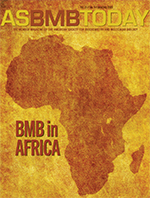 June/July
June/July
In our BMB in Africa issue, we introduce you to 16 ASBMB members who were born, grew up and learned to love science in Africa, and we offer a couple of fun feature stories (ice cream! kids’ TV?) related to science on that continent.
 August
August
In our annual careers issue, we get you on the road with a collection of essays designed to guide, inspire and encourage you. Also a look at how labs with two PIs operate and an introduction to (and from) the ASBMB's new president, Ann Stock.
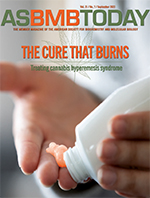 September
September
In this month's issue, we look at cannabis hyperemesis syndrome and its burning cure, the mechanism of an antiviral for monkeypox, and a new book that looks at the biochemical origins of life on Earth.
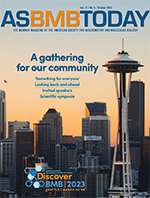 October
October
This month, we look ahead to Discover BMB 2023, the ASBMB’s standalone annual meeting scheduled for March 25-28 in Seattle, with previews of the planned symposia and a historical look from the chair of the Meetings Committee. Also, a big feature about the current state of chronochemotherapy.
 November
November
This month, we’re proud to bring you the Climate Change Issue of ASBMB Today with nine special articles and interviews exploring the intersection of biochemistry and the global environmental crisis. Also, meet all of our 2023 annual award winners.
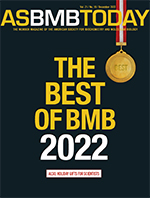 December
December
In this issue we share our Best of BMB 2022 — nine exciting developments in biochemistry and molecular biology, suggested by ASBMB members and pulled from science headlines. Also a Q&A with structural vaccine designer Jason McLellan. And our annual gift guide!
 January
January
In our third annual Wellness Issue, we offer a variety of essays on how people are keeping themselves well in the midst of the COVID-19 pandemic. Their simple strategies include exercise, reading, connecting, celebrating and helping others. Also, a first-person account of taking the at-home SARS-CoV-2 spit tests.
 February
February
To mark Black History Month, we look at how urban universities are working to be better neighbors as part of what's called the anchor movement. A Spelman College professor explains how Black women scientists must navigate a crooked room. And the NIH All of Us program aims to bring greater diversity to genetic data records.
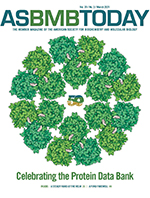 March
March
We celebrate the 50th anniversary of the Protein Data Bank and meet some up-and-coming researchers who will present their work at the 2021 annual meeting. And as Steve Miller takes the helm, we bid a fond farewell to Barbara Gordon, the ASBMB’s longtime executive director.
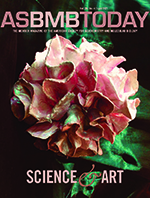 April
April
In our first Science & Art issue, we look at the creative ways biochemistry can be communicated and interpreted through illustration, painting, sculpture, animation, textiles — even dance — and how some artist–scientists carve out a career that combines their talents.
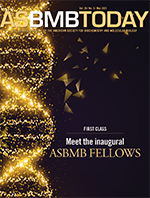 May
May
This month, we introduce the inaugural class of ASBMB fellows, share the winners of our “aha moments” essay contest and look at a project to target 20,000 proteins by 2035.
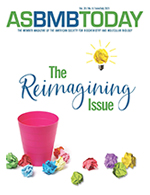 June/July
June/July
In our reimagining issue, we present a dozen glimpses of how science and academia might change for the better. These proposals range from vast systemic upheaval to tweaks in individual mindset.
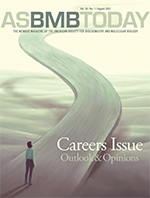 August
August
In our annual Careers Issue, we look at the impact of COVID-19 on faculty hiring, and our writers share nuts and bolts advice on everything from structuring a research paper to asking questions in interviews, personal stories about professional journeys, and lessons learned about mentoring and more.
 September
September
In this month’s cover story, we take a look at the potential ethical issues that are raised as proteomics studies become increasingly detailed. And we chat with Karin Bornfeldt, a JLR associate editor.
 October
October
In this month’s issue, we take a look at apprenticeships in the life sciences, chat with the organizers of the Deuel conference and kick off 2022 annual meeting coverage with a letter from the co-organizers and a look at the ASBMB’s 10 symposia.
 November
November
This issue’s cover story is about science apprenticeships, and we encourage you to listen to the audio version. Also inside: a big feature on the ASBMB Undergraduate Poster Competition and lots of science news.
 December
December
This month we take a highly subjective look back at the biggest BMB work of 2021. We also offer our holiday gift guide and present profiles of the ASBMB’s 2022 award winners.
 January
January
In this issue, we focus on wellness, so you'll see a lot of stories and essays about surviving and thriving as a scientist and a human being.
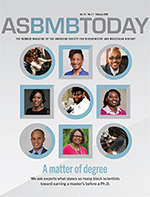 February
February
For our cover story, science writer Laurel Oldach asked experts what steers so many black scientists toward earning a master’s before a Ph.D.
 March
March
Our cover story is about squids that can produce a dazzling display of changing iridescence by manipulating the way light bounces off their skin.
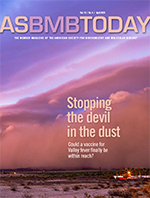 April
April
On the cover: As clinicians, veterinarians and research scientists close in on potential vaccines for the devastating fungal illness Valley fever, the largest barrier likely remains outside the lab.
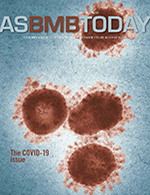 May
May
In this issue, we bring together our coverage to date of COVID-19, including research into the drugs chloroquine and remdesivir as well as reports from members living and working in the pandemic.
 June/July
June/July
This month’s cover story is about a lab that has pivoted its research from carnivorous plants to lead a consortium in a hunt for protease-inhibiting antivirals. Also, an interview with a research–clinician on the COVID-19 front lines.
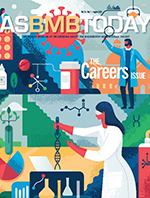 August
August
In this issue, we focus on the challenges of forging a science career, especially during the COVID-19 pandemic. And we chat with Toni Antalis, the ASBMB’s new president.
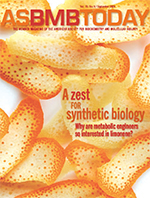 September
September
In this issue, Laurel Oldach looks at synthetic biology, specifically attempts by metabolic engineers to recreate limonene — an essential oil found in orange peels. And John Arnst talks to the two editors who run the Journal of Lipid Research half a world away from each other.
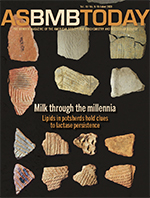 October
October
In this issue, our cover story, “Milk through the millennia,” explains how lipids in ancient pottery shards hold clues to lactase persistence. And we look at how the COVID-19 pandemic has disrupting the NIH funding system — and what’s being done to keep the dollars flowing.
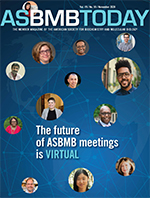 November
November
In this issue, we look into how ASBMB meetings are going virtual, we talk to scientists who made the mid-career leap from academia to industry, and we have conversations with several interesting women.
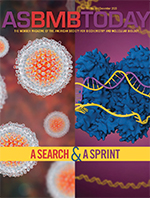 December
December
This month we profile Charles Rice, who shared the 2020 Nobel Prize in physiology or medicine for discoveries leading to identification of the hepatitis C virus, and the duo of Jennifer Doudna and Emmanuelle Charpentier, who received the 2020 Nobel in chemistry for their contributions to CRISPR–Cas9, a genome-editing technology.
To start the new year right, we offer a collection of articles, essays and tips on taking care of yourself and others. Plus our first (bio) chemical element of the month, our first Night Shift essay, and advice on how to patent an antibody.
After a 10-year decline in transfusions and donations, the goal of generating universal blood may be making a comeback; we look at the business and science of blood types in this month’s issue. Also, annual meeting advice for undergrads and a Black History Month retrospective collection.
As we gear up for the ASBMB’s annual meeting, meet 14 early-career investigators who will speak at special symposia hosted by the society’s three journals. Also in this month’s issue, an interview with Phyllis Hanson, a JBC associate editor, and a personal essay about the benefits of the IMAGE grant-writing workshop
It’s annual meeting time. Meet all the ASBMB award winners. Read about some new sessions. Check out a list of activities in Orlando, courtesy of our University of Central Florida student chapter. Also in this month’s issue, we have a Q & A with JLR editor Jean Schaffer.
For a lipid to be clinically useful, researchers must agree on its identity and on how much of it to expect in a healthy person. In this issue, Laurel Oldach chronicles the field-wide effort to work toward such agreements. And we talk to JBC associate editor Karin Musier–Forsyth about her research and teaching.
In this issue, we address the issue of legally mandated mental health accommodations for trainees and researchers in the life sciences. We also look at ketamine, a fast-acting drug that offers a new way to treat depression, and invite you to meet a Princeton postdoc who studies the link between met
In our annual careers issue, we look at how scientists form startups and offer advice on everything from business cards to midcareer malaise. Also, a Q&A with Mike Shipston, an associate editor for the Journal of Biological Chemistry.
This month, we look at efforts to find a cure for Duchenne muscular dystrophy, a genetic disease that affects one in 3,500 male babies. And you can read all about the eight thematic sessions planned for the 2020 ASBMB annual meeting in San Diego.
This month, we look at how the founder of Impossible Foods used biochemistry to build a beefy-tasting plant-based burger. Also, meet Elaine Fuchs, one of the first researchers to study skin-derived stem cells, and Sandhya Visweswariah, a biochemist and groundbreaker for women in India.
Science writer John Arnst talks to researchers who use cryo-electron microscopy to study recently identified giant viruses that steal the genes of their prey. We also meet Sean Davidson, a Journal of Lipid Research associate editor, and talk to the 12 researchers who will receive awards at the 2020 ASBMB annual meeting.
This month, contributing writer Alyson Smith takes us inside the labs of Danny Reinberg and Shelley Berger who use ants to study epigenetics. Staff writer John Arnst talks to Nobel laureate Gregg Semenza about hypoxia. And it’s our annual gift guide!
One hundred days after Hurricane Maria devastated Puerto Rico, we look at how the island’s scientists have overcome damaged labs to persevere with their work. Kelly Chacón describes battling imposter syndrome in her quest for a science career. And we remember Ken Neet, a valued ASBMB member.
In the February issue, we mark Black History Month with a look at health disparities research and a Q&A with college and university presidents from underrepresented groups. Ashley Warfield-Oyirifi lays out a plan to situate the sciences in their social context to retain students of color.
This month, we look at myalgic encephalomyelitis, aka chronic fatigue syndrome; the NIH recently announced $7 million in designated funding, but advocates say that’s nowhere near enough. JBC associate editor Ursula Jakob discusses her work with bacterial bleach.
The April issue of ASBMB Today is full of information you’ll need if you’re attending the 2018 ASBMB Annual Meeting. Find profiles of this year’s annual award lecturers, a map of main attractions in San Diego (aka beaches), a dining guide and a schedule of sessions about life outside of the lab.
This month we look at the puzzle of Parkinson’s disease and recent efforts to address the aggregation of misfolded alpha-synuclein before it reaches the brain. JBC associate editor Chris Whitfield talks about his research into bacterial polysaccharides.
In the June/July issue of ASBMB Today, John Arnst writes about the machinists and engineers at the National Institutes of Health who strive daily to create lab equipment for biomedical researchers with evolving demands. And Laurel Oldach tells the story of two grad students who met at a conference, cooked up a study and cracked at puzzle at the heart of Lyme disease treatment. Plus a collection of photos from the 2018 annual meeting in San Diego.
In our special August careers issue you’ll find inspiration, advice and stories from professionals at all stages of their career journeys. Also — an interview with Jerry Hart, the ASBMB’s new president; an essay on the perils of a colorblind ideology, and a remembrance of Nobel Prize winner Paul Boyer.
In the September issue of ASBMB Today, science writer Laurel Oldach takes a deep look at sexual harassment in science — as the #metoo movement reaches research labs, activists ask universities, funding agencies and scientific societies to do more about the problem. And from our annual meeting prog
In the October issue, we offer a round-up of the scientific sessions planned for the 2019 ASBMB annual meeting. Also, an in-depth Q&A with Mona Nemer, Canada’s top science adviser; a look at how researchers are speeding up plant growth; and some advice on writing an abstract that gets noticed.
In the November issue, we look at the future of fighting flu and the challenges of developing a universal vaccine. Also, a conversation with JBC Associate Editor Karen Fleming, some suggestions for NIH funding policies, and a PI in Israel crowdsources his lab manual on Twitter.
In the December issue, read about a legal wrangle over a monoclonal antibody patent that might go before the Supreme Court next year — and set a precedent for the biotech industry. Also, the final essay in our When Science Meets Sickness series and our 2018 holiday gift guide!
The cover story for this issue, written by Rajendrani Mukhopadhyay, explores how molecular biologists and clinicians figured out how an enzyme involved in ubiquitination plays a role in a rare, genetic disorder of the immune system. In a Q&A, John Arnst interviews biochemist Michael Wolfgang of Johns Hopkins University about his work in lipid metabolism. There also is an essay from a scientist who describes his battle with alcoholism. As always, the magazine offers a variety of stories, such as journal news, member updates and perspectives.
The cover story for this issue, written by John Arnst, describes how a partnership between the National Institutes of Health and the family of Henrietta Lacks is helping researchers access the HeLa genome. There also an essay about imposter syndrome in minority graduate students as well as a piece by a biochemist who found his way to patients’ bedsides in an unconventional way. As always, the magazine offers a variety of stories, such as journal news, member updates and essays.
The cover story for this issue is written by a high-school biology teacher who teaches cell biology by getting his students to run social-media campaigns. There also is a Q&A with Kenneth Gibbs, Jr. who published a paper with his colleagues a few months ago that tackles the issue of diversity in medical school faculty. As always, the magazine offers a variety of stories, such as journal news, member updates and essays.
For this month’s cover story, ASBMB’s science writer John Arnst explores the persistent problem of biofouling that have plagued ships since the dawn of sailing. The issue also contains highlights about the 2017 ASBMB Annual Meeting as well as stories about this year’s cohort of annual award winners. There also is a trio of essays that explore how foreigners influence science in the U.S. As always, the magazine offers a variety of stories, such as journal news, member updates and essays
In her final cover story as ASBMB Today’s managing editor, Rajendrani Mukhopadhyay explores why the National Institutes of Health is preparing to fund cryo-electronmicroscopy facilities across the nation. The issue also contains a feature about how serendipitous meetings and basic biochemistry accelerated the push for a cure for the rare and fatal Lafora disease. In the news section, learn about new research on wasp venom and corneal disease. The Perspectives section offers the next essay in our ongoing “Do-Overs” series and advice pieces on finding careers beyond academia and writing emails that won’t induce anxiety in recipients.
In this summer issue, science writer John Arnst reports on what researchers know and don’t know about the science of kratom, a plant increasingly consumed by opioid addicts seeking relief from withdrawal symptoms. The issue also includes videos of interviews of the ASBMB’s 2017 award winners and audio of their award lectures. Don’t miss ASBMB members’ essays on the public’s diminishing faith in science and how to covercome a tenure denial.
In this issue, you’ll find advice to help you succeed in a variety of work environments. Angela Hopp provides a laundry list of the ASBMB’s career-related offerings. Diedre Ribbens offers tips on productivity. A quartet of authors provides lessons on emotional resilience. Raphael Luna explains the value of mentoring. Kathy Goss outlines how to segue to a nonresearch position in academia.
This month kicks off coverage of the 2018 ASBMB Annual Meeting. Martin Spiering tells you how to write a great conference abstract. Dani Rabaiotto and Jeff Clements guide you through the question session. Yan Jessie Zhang and Comfort Dorn give you the lowdown on Spotlight Sessions. Also in this issue, John Arnst interviews Russel Debose–Boyd, a new associate editor at the Journal of Lipid Research, and H. Alex Brown, a leader in lipidomics, is remembered by his colleagues.
This month, we tell you all about PROLAB, a travel grant program that helps emerging scientists from overseas gain experience in labs in the U.S. and Canada. We also remember C.C. Wang, a crusader against parasitic diseases, and you can find out all about the scientific sessions scheduled for the 2018 annual meeting.
In this issue, read about the tiny mouse lemur of Madagascar, a promising model for the study of human lung disease. You can also learn how to keep your data safe, how to put in your two cents about the future of research funding and how to find a mentor at the 2018 annual meeting.
This month, we take a deep dive into the circadian coupling of cellular and solar clocks, in honor of the three American chronobiologists who won a 2017 Nobel Prize. And we celebrate the season with our annual gift guide for the science lovers in your life. Also, meet the editor who helps Journal of Biological Chemistry authors finesse their abstracts and get straight talk from the Office of Research Integrity on misconduct and questionable practices in the lab.
On our cover, chief science correspondent Raj Mukhopadyhay looks at fresh developments in the loosely defined field of quantum biology, including attempts to design relevant experiments and develop models that can demonstrate quantum effects in biological processes. She hears from researchers who have observed quantum effects – in enzyme catalysis, photosynthesis, and the sensing of magnetic fields by migratory birds – but remain careful about embracing quantum biology as a fully-fledged niche.
This month’s ASBMB Today contains a special section on diversity and inclusion in the life sciences. Check out some pointed words on the topic from members and affiliates, a Q&A with NIH’s top diversity officer and articles from underrepresented minority contributors who propose meaningful steps for increasing diversity and inclusion. Also see our feature about the Human Placenta Project, which aims to reveal what goes right and what goes wrong with the puzzling organ.
Our March issue looks ahead to the 2016 ASBMB annual meeting in April, with guides to special meeting events and profiles of our 16 annual award winners. We discover a bioartist who uses DNA phenotyping to create startling 3-D portraits of strangers, and science writer Alexandra Taylor delves into the life of C.C. Wang, a biochemist who modernized the field of parasitology.
In our May issue, chief science correspondent Rajendrani Mukhopadyhay interviews popular speaker Fyodor Urnov, a researcher at Sangamo BioSciences who is an expert in zinc finger nucleases and helped coin the phrase “genome editing.” We speak with a bioartist who is creating new concepts of clothing inspired by the actions of bacteria that coat human skin, cover important new developments in education and outreach, and publish a song parody involving quorum sensing, Princeton’s Bonnie Bassler, and Madonna that’s guaranteed to make you grin.
In our May issue, chief science correspondent Rajendrani Mukhopadyhay tells the evolving story of lysosomes. Once thought to serve as trash cans for the cell, Mukhopadhyay says lysosomes are having a “Cinderella moment” as researchers uncover their myriad contributions to the cell’s well-being. We also have a profile of the artist Kindra Crick, whose science-infused projects owe some debt to her grandfather Francis (yes, that Francis Crick), and we’re sharing sound advice about connecting with urban K – 12 communities from the outreach folks at The Rockefeller University.
This issue features our first immersive cover story – oversized photos and audio accompany the writing online -- about a Scottish cabbie’s collection of scientist signatures. There’s a Q&A with new ASBMB president, Natalie Ahn, and we profile a microbiome researcher with a passion for educating scientists in his native Armenia.
The cover story for this issue is about the illegal questions that some female candidates face during tenure-track faculty hiring and how those questions derail recruitment of women. There’s also a story on the promise of immunotherapy as well as a section focused on exciting teaching approaches in the life sciences.
This issue contains a special section highlighting the pros and cons of scientists and science communicators engaging on social media. There is also a story about how undocumented immigrants who qualify under Deferred Action for Childhood Arrivals can't get federal funds to do research.
The cover story for this issue, written by Angela Hopp, details the efforts of one woman to bring Native American students to the National Institutes of Health so they get to experience the thrills of biomedical research. There also is a message from Natalie Ahn, the current president of the society.
The cover story for this issue, written by John Arnst, details the pitfalls in trying to establish a baseline testosterone level in elite women athletes. There also is a special section that describes all the exciting programming scheduled for the next ASBMB annual meeting. The abstract submission deadline for the meeting is Nov. 17. As always, the magazine offers a variety of stories, such as journal news, member updates and essays.
The cover story for this issue is about autophagy. John Arnst, ASBMB’s science writer, describes how Yoshinori Ohsumi’s work on the process, for which he won this year’s Nobel Prize in physiology or medicine, has opened up new avenues of investigation in cell and molecular biology.
In the January issue, our Defying Sterotypes series continues with two stories about scientists working in Hollywood. We also have a Q&A with Dennis Voelker, a new associate editor for the Journal of Biological Chemistry. ASBMB President Steve McKnight writes about the work of Zhijian “James” Chen, a plenary lecturer at the forthcoming ASBMB annual meeting in Boston and the winner of the ASBMB–Merck award. Aditi Dubey kicks off our "Hobbies" series with a poem about a beverage popular among graduate students. ASBMB Today science writer Rajendrani Mukhopadhyay writes about George Todaro to launch our "Generations" series. Andrew D. Hollenbach writes about how he got where he is today. We hope you enjoy the January issue!
Do extracellular vesicles containing RNA represent a new mode for cellular communication? In the February issue, science writer Rajendrani Mukhopadhyay explores if these vesicles challenge the dogma that RNA strictly is an intracellular molecule. Our Defying Sterotypes series continues with an interview with runner Nick Symmonds, who put science aside to chase his dream of going to the Olympics. We also have a feature on how deaf scientists navigate the hearing scientific community. In his column this month, ASBMB President Steve McKnight writes about the forthcoming ASBMB annual meeting in Boston. For our "Generations" and "Hobbies" series, Maggie Kuo writes about Jackie Corbin's favorite pastime and how a research team at Case Western Reserve University generated a mouse model for psoriasis. Read the issue!
As the American Society for Biochemistry and Molecular Biology annual meeting approaches, we have lots of information to share with you! Be sure to check out our coverage of the ASBMB annual award winners and plenary lecturers, all of whom will give talks in Boston later this month. On our cover, we feature Jerry Greenfield, the scientific brain behind the Ben & Jerry's ice cream brand. As always, we have plenty of news from the ASBMB journals. Our "Generations" series continues with looks back and forward from scientists of different generations. Our "Hobbies" series continues with a tale of star-studded travel and a note from a fashion lover who will be one of five annual meeting bloggers and tweeters. Finally, don't miss the essays from Sharon Rozovsky and Karl Booksh, who run a summer undergraduate research program at the University of Delaware for students with disabilities. We hope you enjoy this gigantic issue!
On our cover, we feature Vikram Mulligan's stunning artwork, which he creates when he's not doing protein-folding research at the University of Washington. Our Defying Stereotypes series continues with a story about two professional cheerleaders who teach and study science. Don't miss our coverage of recent publications in ASBMB journals, including a new review series in the Journal of Biological Chemistry about G-protein–coupled receptors and a Molecular & Cellular Proteomics paper about a hamster model for hemorrhagic fever. In his President's Message, Steven McKnight writes about the grant-review process at the National Institutes of Health and how it is like — and unlike — the review process at the Howard Hughes Medical Institute. Finally, we offer two must-read essays: one by a researcher forced to close his lab and another by a Ph.D. student who decided to learn to play the viola as an adult. We hope you enjoy the April issue!
On our cover, we feature biochemist Peggy A. Whitson, who will head out again next year to the International Space Station, where she will conduct experiments for many Earth-bound scientists. This issue contains two installments in our Defying Stereotypes series about people with scientific training who have careers away from the bench: One story is about sportswriter Jay Jaffe, and the other is about bestselling romance novelist Stephanie Laurens. This issue includes tips for undergraduates embarking upon their first research experiences and words of wisdom for new Ph.D. recipients. In the President's Message, Steve McKnight takes a look at the scoring criteria for National Institutes of Health grants and proposes a new approach to NIH grant review. For Lipid News enthusiasts, Symeon Siniossoglou discusses the "many faces of lipins." Finally, don't miss this issue's three contributions to the "Generations" series. We hope you enjoy the May issue!
On our cover, we feature a story about a rare brain tumor that always has seemed unstoppable. But a recent discovery might mean there is reason for hope. Our Defying Stereotypes series comes to a close with a profile of Joe Wong, a scientist and comedian.
On our cover, we feature a special section on education and professional development. The contributors to this section provide advice for those trying to get over the Ph.D. hump and for those picking a graduate school program or postdoctoral position. The section also features lessons that can be learned from the mistakes of senior scientists and tips on getting the most out of myIDP. We hope you enjoy the issue!
Our cover story is about optogenetics, which has had a significant impact on the field of neuroscience and stands to do the same for cell biology. We have two other feature stories: One is an interview with a teenager who just finished his biochemistry degree, and the other is a profile of a pharma.
On our cover, researchers studying cancers in pet dogs are gaining insights into human forms of the disease. We have a preview of our 2016 ASBMB Annual Meeting, including symposia descriptions, links for submissions, and interviews with plenary speakers.
The U.S. biomedical research enterprise depends heavily on scientists who were born overseas. In this month’s cover story, chief science correspondent Raj Mukhopadhyay writes about the complex legal pathway to work for foreign scientists in the U.S.
Four of 2015’s Nobelists in chemistry and medicine are ASBMB members. In our two cover stories, Alexandra Taylor talks with the three chemistry winners about their advances in DNA repair and digs into the science behind the medicine prize, which is shared by a member for his work on ivermectin, a drug that’s helped radically lower incidence rates of river blindness and elephantitis. The issue also contains our biggest science-themed gift guide ever!
The cover story of the January 2014 issue features Jennifer Fairman, the medical illustrator recruited to help produce a special issue of the journal Molecular & Cellular Proteomics. Our editorial board chairman, Charles Brenner of the University of Iowa, demystifies faculty salaries, and contributor Joe Tiano of the National Institutes of Health shares advice and resources for making sure your digital footprint doesn’t hamper your job search. Journalist and photographer Michael Mira launches to reader-contributed part of our Open Letters series with “a belated love letter” to his first-grade science teacher. You probably noticed that we have a new logo. Find out more about our redesign.
The cover story of the February 2014 issue is about white spot syndrome virus, which threatens shrimp and those who make their living cultivating them. Benjamin D. Caldwell, dean of the Missouri Western State University Graduate School, writes about what it’s like to become a member of the administration, or, as some say, to move over to “the dark side.” Our “Open Letters” series continues this month with a piece from Akshat Sharma, who submitted a version of a letter he once sent while applying to a science-writing program (before he decided to stick with immunology). For those of you considering attending the ASBMB’s symposium about massive online open courses at the annual meeting in San Diego in April, we have a roundtable-style Q&A with Joseph Provost and Michael J. Pikaart about the potential impacts of MOOCs and the implications for brick-and-mortar colleges and universities.
In the cover story of the March 2014 issue, contributor Diedre Ribbens explores the causes of seasonal affective disorder, or the “winter blues.” Also, we offer two Q&As by science writer Rajendrani Mukhopadhyay: one with John Denu, a new associate editor at the Journal of Biological Chemistry, and one with Jonathan Weissman, the plenary lecturer for the ASBMB annual meeting next month in San Diego. In his “President’s Message,” Jeremy Berg analyzes the effects of the across-the-board federal budget cuts on investigators seeking R-series grants from the National Institutes of Health. And, on a related note, ASBMB’s public affairs director, Benjamin Corb, writes about why it’s so hard to secure increased research-funding appropriations even when politicians throughout the political spectrum agree on science’s value to the nation and humanity. Finally, we begin our coverage of the ASBMB annual award winners. We will feature the remaining winners next month.
In the cover story of the April 2014 issue, science writer Rajendrani Mukhopadhyay explores new research on the parasitic jewel wasp, which bewitches its prey with a special venom, turning it into a willing participant in its own demise. In a Retrospective article, colleagues remember Richard Hanson, a former ASBMB president and Journal of Biological Chemistry associate editor. In his “President’s Message,” Jeremy Berg evaluates the role of serendipity and asking the right research questions. Finally, we complete our coverage of the ASBMB annual award winners.
In the cover story of the May 2014 issue, science writer Rajendrani Mukhopadhyay talks with Norman Lewis of Washington State University. Lewis’ group is exploring how common trees can be engineered to produce high-value commodities. In one of his last columns as president of ASBMB, Jeremy Berg reviews two books that you might want to add to your summer reading list. Our Perspectives section is brimming with ideas and advice this month. Check out Philip Yeagle’s open letter of thanks to a special group of researchers, Andrew D. Hollenbach’s advice for Kirschstein NRSA grant applicants, and Brent R. Stockwell and Michael Cennamo’s article about “flipping” the biochemistry classroom at Columbia University.
In the cover story of the June/July 2014 issue of ASBMB Today, science writer Rajendrani Mukhopadhyay explores a longstanding controversy over how much vitamin D is enough for good health. While the Institute of Medicine raised the recommended daily intake to 600 IUs in 2011, some say the limit should be increased more in light of mounting (but not yet conclusive) evidence that vitamin D does a lot more than promote bone health. In his final column as president, Jeremy Berg reflects on the ASBMB annual meeting and announces his new blog, Datahound. Our Perspectives section is full of commentary about careers. Check out Bill Sullivan’s open letter to his parents about becoming an academic researcher, blogger Prof-like Substance’s thoughts about being a “cool professor” and Andrew D. Hollenbach’s essay about what it means to be a successful mentor. Plus, learn about a two-part course on science communication taught by Thomas O. Baldwin at the University of California, Riverside.
In our cover story, we learn about Jennifer Doudna's groundbreaking work on CRISPR and Cas9 and about her close relationship with her lab manager, who she says has played a pivotal role in her group's success. Thinking about making the jump from a faculty position to a spot in your institution's administration? See our second article in a series about moving to "the dark side" by Benjamin D. Caldwell and Mary Huff. Meanwhile, contributor Andrew Hollenbach writes about overcoming a significant roadblock on his career path: panic attacks. And Milton J. Cormier and Richard O. McCann write about the role of the Cormier lab in the cloning and expression of the GFP gene. Last, but not least, don't miss the first "President's Message" by ASBMB President Steven McKnight, who, by the way, will participate in a live-streamed Q&A session Aug. 11. Get your questions ready!
The September 2014 issue is chock-full of great reads! It marks the launch of an exciting series of articles about people who were trained in science but who have made their livings (and sometimes fortunes) in totally different professions. First up: punks who publish! In the second column of his presidency, Steve McKnight gives you his take on why the review process isn't what it should be. You'll notice we have included a number of obituaries for ASBMB members this month. One is about Roy P. Mackal, who chose a very different path than most biochemists. Lastly, we close out our Open Letters series with a piece by Kelly Hallstrom, who has some advice for the most recent cohort of graduate students. We hope you will enjoy — and share — the September issue!
The October issue continues our "Defying stereotypes" series of articles about people who were trained in science but who have made their names in other ways. In this issue, we feature Craig Breslow, a brainy baseball player who worked under scientist Joan Steitz at Yale University. We also have a feature on Michael Weiss at Case Western Reserve University, whose company, Thermalin Diabetes, is gearing up to do human trials of an ultraconcentrated, rapid-acting insulin analog. In our perspectives section, Bob Eisenberg of Rush University Medical Center asks, "Shouldn't we make biochemistry an exact science?" And we're proud to report that two ASBMB members won the 2014 Lasker award for their work on the unfolded protein response. We hope you will enjoy — and share — the October issue!
The November issue has something for just about everyone. In the mood for something serious? Our big feature story is about thalidomide, a drug that in the 1950s was found to cause severe birth deformities but that today is used as a cancer therapy. Need a pick-me-up? This month's installment of our "Defying stereotypes" series profiles Nina Davuluri, a brainy beauty queen who advocates for STEM education. Like a little controversy? Read two reader responses to ASBMB President Steve McKnight's September column about study sections, and read McKnight's latest column defending his record when it comes to supporting early-career scientists. Need something super cool to post on social media? Check out these pretty images from the FASEB BioArt contest. Lastly, consider taking our reader survey so that we can better serve you. We hope you enjoy the November issue!
Our Defying Stereotypes series continues with two stories about women who've found ways to professionally blend science and art. Our science writer reports on how Smithsonian scientists are trying to figure out some little details that will make a big difference in their genomic research endeavor. ASBMB President Steve McKnight tells a story about "a triumph of science." Our intern, Maggie Kuo, profiles a graduate student who regularly appears on shows like "The View" to inspire the public to embrace and experiment with science. And, for those of you still doing holiday shopping, we scoured CafePress to find the best mugs for scientists.
The cover story of the January 2013 issue of ASBMB Today reports on the results of a recent ASBMB survey of young biochemists and molecular biologists. In a sidebar, Fred Maxfield of Weill Cornell Medical College, who leads the ASBMB committee focused on mentoring, writes about what the respondents had to say regarding the advice they receive. Also in this issue are preview articles about the 2013 ASBMB Special Symposia lineup. And, for those of you uncertain about how using certain social media tools can benefit you personally and professionally, Rajini Rao of the Johns Hopkins University School of Medicine offers a testimonial on the value of Google Plus.
In the February 2013 issue of ASBMB Today, our personal essay series “Derailed but Undeterred” launches with a piece by Wendy Knapp Pogozelski called “The uses of metabolic adversity.” For the cover story, “The other malaria parasite,” we talked to researchers studying the ill-understood parasite that causes most malaria cases outside of Africa. Meanwhile, in the mentoring column, Jim Keen offers some advice for those just embarking upon a life of academic research. And contributor Cristy Gelling interviews artist and science student Maja Klevanski, who sees structures in the Protein Data Bank in very unique ways.
In the March 2013 issue of ASBMB Today, the second installment of our personal essay series, “Derailed but Undeterred,” is by Martha Lewis, who fled Sierra Leone as a child and now is pursuing a career as a physician–scientist. You’ll also find the first part in our two-part coverage of the society’s annual award winners. Look for others in the April issue. In the minority affairs column, Squire J. Booker writes about making careers in science accessible for those with disabilities. And we have news items from the ASBMB journals.
In the April 2013 issue of ASBMB Today, the third installment of our personal essay series, “Derailed But Undeterred,” is by Aditi S. Iyengar, who writes candidly about the highs and lows of graduate school. You’ll also find the second part in our two-part coverage of the society’s annual award winners. Our cover story reviews what is known about the molecular underpinnings of Alzheimer’s disease and offers perspectives from two women caring for their declining mothers. In an online exclusive article, contributor Connor Bamford talks to scientists studying triple-negative breast cancer, an area of research that will be given special attention at the ASBMB annual meeting later this month.
In the May 2013 issue of ASBMB Today, we explore what we know — and what we need to know — about sperm and how it relates to male infertility. The fourth and fifth installments of our personal essay series, “Derailed but Undeterred,” are by Christine Guthrie, who candidly tells how she prevailed through a particularly dark period when she was a young investigator, and by Jonathan Gitlin, who recalls the challenges he experienced as a noncitizen forging a career in U.S. science policy. You’ll also find a Retrospective article about the late Wm Wallace “Mo” Cleland and a feature by contributor Diedre Ribbens about the uptake of digital PCR by some researchers seeking to solve certain types of problems. And don’t miss our Journal News highlighting two new minireviews in The Journal of Biological Chemistry, a thematic series on microRNAs in the Journal of Lipid Research and a special issue of Molecular & Celullar Proteomics focused on glycoscience.
In the summer issue of ASBMB Today, we explore the mysteries of spider pheromones with a Q&A with Stefan Schulz. ASBMB President Jeremy Berg reviews the National Institutes of Health’s BRAIN initiative. And contributor Lola Olufemi offers ideas for reducing laboratory expenses. Meanwhile, in this month’s installment of the special essay series “Derailed but Undeterred,” Bethany Brookshire, a blogger for Scientific American more commonly known by the moniker Scicurious, writes about her experience with imposter syndrome. As a reminder, ASBMB Today will resume monthly publication in August.
The August 2013 issue of ASBMB Today is more jam-packed than usual, and it promises to have a little something for everyone. In our Brown Bag special section, we offer news, advice and perspectives about various aspects of work and school. This month’s captivating contribution to our ongoing personal essay series is by Harvey “Jim” Armbrecht, who writes about his wife’s diagnosis of Lewy body disease and about the SAMP8 mouse, a model for early memory loss. We also offer a profile of the University of Pennsylvania’s Virginia Lee and launch our new Point/Counterpoint column with Eleftherios P. Diamandis and Peter J. Kennelly providing their perspectives about paying peer reviewers. In the President’s Message, Jeremy Berg explores what a sustainable biomedical enterprise might entail.
The cover story in the September 2013 issue of ASBMB Today is about investigators who are juggling the demands of laboratories in two places at once. We have two Career Insights articles: one about how to compete with those lab diva-types and one about how to conduct salary negotiations skillfully. Contributor Lauren Amable profiles artist Lynn Fellman, who has embraced her new role as a biological science illustrator, and contributor Kamalika Saha interviews ASBMB member Ritankar Das, who graduated from the Universtiy of California, Berkeley, at the top of his class — at age 18. In addition, David J. Kroll, a columnist for Forbes magazine, writes about the work environment and science-outreach efforts at the North Carolina Museum of Natural Sciences, where scientists do their research in full public view. Last, but not least, we hope you’ll consider submitting an open letter for our forthcoming series.
The cover story of the October 2013 issue delves into what we know about protein evolution and explores the debate over whether function or structure first arose in primitive peptides. This month’s Derailed but Undeterred contribution by F. Peter Guengerich marks the end of the personal essay series. For job-seekers and new (or struggling) managers, we have two Career Insights articles: In the first one, seasoned lab managers offer their advice on how to run a research group; in the second, Bill Sullivan provides do’s and don’ts for postdoctoral application cover letters. Lastly, don’t forget to submit an open letter for our forthcoming series, Open Letters. The deadline is Dec. 31.
The cover story of the November 2013 issue offers a big helping of food for thought. Intrigued by a message on her favorite pizza chain’s packaging, science writer Rajendrani Mukhopadhyay dared to ask the experts, “Is the glycemic index a useful measure of carbohydrate metabolism?” The answer, it seems, depends upon whom you ask. In the education column, members of the ASBMB Research Coordination Network steering committee introduce a forthcoming toolkit for BMB educators. And contributor Mark Stewart writes about the rewards and perils of using crowdfunding to finance research projects.
The cover story of the December 2013 issue features Hudson Freeze, a winner of the 2013 Golden Goose award for the discovery of Thermus aquaticus. Contributor Thomas E. Schindler offer a heartfelt essay about how his family dealt with a devastating diagnosis for their daughter: stage IV neuroblastoma. (Spoiler alert: His story has a happy ending!) And, just for fun, we collected tweets from biochemistry and molecular biology students about their favorite and zany professors. (Profs, don’t be scared!)
In the January 2012 issue of ASBMB Today, science writer Raj Mukhopadhyay reports on efforts to overhaul the Western blot three decades after its inception. She also talks with W. Neal Burnette, who as a postdoc developed the now-ubiquitous technique. If you received an iPad this holiday season, check out a list of 10 apps that will make your work and life more organized and productive. This issue also offers columns about working at teaching institutions, surviving grad school and leaving the lab to help defense-oriented policymakers better understand scientific concepts.
In the February 2012 issue of ASBMB Today, we highlight the 2012 Special Symposia Series, report the results of a new survey about ASBMB women in academe and profile several of our annual award winners. Meanwhile, science writer Raj Mukhopadhyay talks to Phil Leder and F. Anne Stephenson about their careers and outlooks. If you advise undergrads, we recommend checking out Peter Kennelly's tips for avoiding the "expectations trap" and other pitfalls. Plus, we offer a downloadable poster for the Science Superhero Series for undergrads at the annual meeting in April.
In the March 2012 issue of ASBMB Today, we offer premedical curriculum recommendations in response to the revised MCAT. We're also launching a new educational resource chronicling women's contributions to biochemistry and molecular biology that we hope you'll help us expand. Meanwhile, for those attending the annual meeting in April, we have a roundup of science-communication events and tips for tweeting and touting the work you'll be showcasing. Also look for three Q&As with new associate editors at the Journal of Biological Chemistry and Molecular & Cellular Proteomics and a profile of the newest member of the Minority Affairs Committee.
In the April 2012 issue of ASBMB Today, science writer Raj Mukhopadhyay explores what should be done with the mountains of -omics data coming in and how it should be validated. For those attending the annual meeting in San Diego later this month, we have a roundup of special events and the winning entries from our poetry contest. Meanwhile, Sonia C. Flores offers step-by-step instructions for submitting a grant proposal to the National Institutes of Health, and readers respond to the ASBMB recommendations for premedical curriculum modifications leading up to the revised MCAT.
In the May 2012 issue of ASBMB Today, science writer Raj Mukhopadhyay profiles scientist-turned-artist Robert Schimke, who once served as president of ASBMB and as an editorial board member for the Journal of Biological Chemistry. Know a student who is graduating? ASBMB Today contributor Connor Bamford lists his top-10 picks for graduation gifts. Whether you made it to the annual meeting or not, we offer a wrap-up that includes tweets, blogs and a slideshow from our on-site tattoo-parlor booth. Also, check out the videos of our Hill Day participants and an essay by Deborah L. Neely–Fisher, who addresses the well-documented repercussions of transfer shock and writes openly about her own experience with it decades ago to persuade others to help create a culture of undergraduate research at community colleges.
In the June 2012 issue of ASBMB Today, science writer Raj Mukhopadhyay covers the increasingly sophisticated techniques of sports doping and detection. She also profiles George Stark, who contributed to the development of both Western and Northern blotting and who co-discovered gene amplification in mammalian cells and the JAK-STAT signaling cascade. Also, read the introductory column from the ASBMB Mentoring Committee and get pumped for the public affairs team’s summer challenge. Will you be one of the 100 ASBMB members knocking on the doors of lawmakers when they’re at their home offices during the summer recess?
In the July 2012 issue of ASBMB Today, science writer Raj Mukhopadhyay profiles Stanford University’s Michael Snyder, who turned to his mother for help telling his own genetic story, and interviews new ASBMB President Jeremy Berg. Also, read the essay by postdoc Chris Pickett, who writes honestly about the difficulties of landing a science policy job. If you will be one of the 100 ASBMB members knocking on the doors of lawmakers when they're at their home offices during the summer recess, make sure to put the ASBMB advocacy webinars on your calendar.
In the August 2012 issue of ASBMB Today, science writer Raj Mukhopadhyay explores the promise and challenges of targeted therapies. In this cover story, Journal of Biological Chemistry Associate Editor Richard Hanson of Case Western Reserve University shares his experiences with chronic lymphocytic leukemia and how a new targeted treatment has so far kept him out of “the big lab in the sky.” Meanwhile, four contributors address various issues related to the Ph.D. pipeline. ASBMB Public Affairs Director Benjamin Corb expresses frustration over the recent work-force report by the National Institutes of Health working group. Promega Corp.’s Martin Rosenberg raises concerns about what skills new grads aren’t gaining for today’s job opportunities. Jon Lorsch suggests academic mentors reassess what they consider good outcomes of graduate education. And Carolyn Machamer reports on one way Johns Hopkins University is exposing students to career options outside of the lab. Lastly, don’t miss contributor Cristy Gelling’s insightful and frank feature on the creative ways young researchers are balancing their careers and families.
In the September 2012 issue of ASBMB Today, science writer Rajendrani Mukhopadhyay profiles Walt Shaw, who built Avanti Polar Lipids into the business it is today. This issue also contains the first part of a two-issue preview of the 2013 ASBMB annual meeting thematic programming. Find out what the theme organizers have planned. Meanwhile, science blogger and social media maven Biochem Belle contributes an essay about how online communication is changing the way we do science — by providing immediate critique and support, giving wallflowers the virtual podium and connecting researchers who otherwise might never have met. Lastly, ASBMB Public Affairs Director Ben Corb says that, as the “fiscal cliff” approaches, scientists must take a leap of faith in their own abilities to persuade U.S. lawmakers to preserve science funding.
In the October 2012 issue of ASBMB Today, science writer Rajendrani Mukhopadhyay explores new views on the biology of bone. This issue also contains the second part of a two-issue preview of the 2013 ASBMB annual meeting thematic programming. Find out what the theme organizers have planned, and get your abstracts ready. The deadline is Nov. 8! Meanwhile, we have a ton of news from the ASBMB journals, including Journal of Biological Chemistry “Reflections” articles by Reed Wickner and Lubert Stryer, a look back at the life of Swedish lipidologist Sven-Olof Olofsson and a new paper out of Molecular & Cellular Proteomics. Lastly, make sure to check out the ASBMB Today blog, Wild Types, where breaking news and features are posted each week.
In the November 2012 issue of ASBMB Today, contributor John LaCava writes about an initiative he founded to make science mainstream by incorporating the sounds of science into music that moves people. Meanwhile, ASBMB science writer Rajendrani Mukhopadhyay takes a look back at how George and Mildred Burr doggedly pursued the cause of a deficiency syndrome in rats and ultimately changed our view of fats. This month’s issue also contains two “Retrospective” articles: one about the late Annemarie Weber by Clara Franzini-Armstrong and another about the late George F. Cahill Jr. by Richard W. Hanson. Lastly, make sure to check out the ASBMB Today blog, Wild Types, where breaking news and features are posted each week.
In the December 2012 issue of ASBMB Today, science writer Rajendrani Mukhopadhyay writes about a controversy over a dietary recommendation for omega-6 that shows no signs of resolving itself. In his monthly “President’s Message,” Jeremy Berg writes about the recent Nobel Prizes. This month’s issue also contains a great roundup of recent publications in the ASBMB journals, including coverage of a joint “Reflections” article by Leonore and Leonard Herzenberg and a commentary on how high cholesterol levels come in handy during protozoan infection. Lastly, make sure to check out the ASBMB Today blog, Wild Types, for breaking news and features.
In the January 2011 edition of ASBMB Today, you’ll find an interview with scientific sculptor Julian Voss-Andreae, as well as an overview of the most recent UNESCO science report. We also look at some ASBMB members whose research focuses on biological toxins and look back on the lives of Britton Chance and Harvey Itano. And finally, we have a special, online-only editorial in which ASBMB Past-president Gregory Petsko writes an open letter to George M. Philip, president of the University at Albany, SUNY.
In the February 2011 edition of ASBMB Today we celebrate Black History Month with a timeline of noteworthy black researchers and their contributions to the life sciences. We’ve also compiled a brief rundown of some of our favorite fun online science resources, as well as a list of fellowship opportunities for scientists who want to work in the policy realm. We also look at how husband and wife team Ruma V. Banerjee and Stephen W. Ragsdale balance life and the lab at the University of Michigan.
In the March 2011 issue of ASBMB Today we look at how teachers are using cooking to help students learn science. As a bonus, we include several recipes, such as poached pears with caramel sauce and mango pineapple hot sauce. We also talk to Nobel laureate Carol Greider about life after receiving the prize and give some quick tips on making a great poster for the upcoming ASBMB annual meeting. And finally, we consider teamwork in academia and industry and explore fatty acid-mediated regulation of sphingolipid biosynthesis and its role in lipotoxicity.
In the April 2011 issue of ASBMB Today, we give you some last-minute tips on what to attend at the annual meeting in Washington, D.C., this month and also present overviews of the six meetings that make up the 2011 ASBMB Special Symposia Series. We also look at whether or not the major pharmaceutical companies are giving RNA interference the ax too soon and provide a wrap-up of the 2011 ASBMB Hill Day, complete with videos and slideshows.
In the May 2011 issue of ASBMB Today, we look at international science. You’ll find profiles of several of our international members, a look at an organization that donates scientific supplies to resource-poor institutes in developing nations, an overview of a program that trains and unites Peruvian scientists, and resources for scientists interested in training in Europe. We also have compiled a timeline of noteworthy Asian-Pacific American contributions to the life sciences in honor of Asian-Pacific American Heritage Month.
In the June 2011 issue of ASBMB Today, we look at Gary Felsenfeld’s research on chromatin and explore an online video game that’s unexpectedly helping foster science outreach. Joan Herbers, president of the Association for Women in Science, also weighs in on the recent progress women have made, and ASBMB’s Angela Hopp gives tips on writing manuscript titles. You’ll also find photos and videos from the 2011 annual meeting in Washington, D.C., as well as the names of our poster competition winners.
The industry-themed July 2011 issue of ASBMB Today contains profiles of several of our members who work in industry; a look inside a bioprocessing institute in Ireland; an overview of a new European graduate program that bridges academia and the business world; and an article on the search for on alternatives to corn-derived fuel ethanol. You’ll also find the results of the 2011 ASBMB elections and tips on how to read between the lines in a reference letter.
In the August 2011 issue of ASBMB Today, we explore how David Goodsell uses watercolor drawings to showcase the inner workings of the cell, and we peek inside a museum in Singapore that merges art and science. We also look at how ASBMB member Anne-Claude Gingras is providing new insights into phosp
The September 2011 edition of ASBMB Today focuses primarily on education. Our contributors explore the value of mentorship, outreach programming and community-service initiatives and provide K-12 classroom tips and commentary on the status of biochemistry and molecular biology programs.
The October 2011 edition of ASBMB Today contains the first installment of our annual meeting coverage. Read about the forthcoming sessions on DNA, RNA, gene regulation, protein synthesis, lipids and metabolism. Meanwhile, on the journal front, Molecular and Cellular Proteomics’ sponsored lecture series was launched, and a new Herb Tabor Young Investigator Award winner has been named. Also find a feature story on an outreach effort at Washington University in St. Louis.
The November 2011 the edition of ASBMB Today features Ralph Bradshaw’s reflections on the society’s former headquarters and seven Web-exclusive Q&As with longtime Beaumont House staffers. We also have launched an occasional series of reviews of BMB-related blogs. NIH news updates include: The Knockout Mouse Project, new trends in postdoc training and an interdepartmental government consortium working on new chip technology.
The December 2011 edition of ASBMB Today features a story on synthetic biology and its evolution from genetic engineering in the lab to exciting clinical applications. Is synthetic biology ready for its close-up? Billy Hudson rose from humble beginnings with the help of many generous people along the way. Now he’s giving back to the young students who stand where he did long ago. Read about his Aspirnaut Initiative. JBC has recognized several young researchers by choosing them as Herbert Tabor Young Investigator Award winners. Read about them, their research, and their disparate backgrounds.
This issue of the magazine looks at how Anne-Frances Miller is exploring ways to improve sensitivity of NMR spectroscopy. You'll also find retrospectives on Mildred Cohn and Richard I. Gumport, an interview with stand-up science comedian Brian Malow and a look at the University of Oregon's Institute of Molecular Biology.
In honor of Black History Month, the February issue of ASBMB Today looks at Ernest Everett Just and his seminal contributions to the study of fertilization and early development. Also featured, is a Valentine’s article on some ASBMB heart researchers, a retrospective on ASBMB Past-President Edwin G. Krebs and an overview of three ASBMB 2010 award winners.
In the March issue of ASBMB Today, American Society for Biochemistry and Molecular Biology President Gregory Petsko talks about the disconnect between what we teach our grad students and postdocs and what they need to know. You’ll also find a glimpse at Jerry B. Lingrel’s research on the mechanisms of atherosclerosis and hypertension, an overview of the new JBC thematic minireview series on proteases and a look at the two new awards created by ASBMB for 2011.
The April issue of ASBMB Today features an interview with PHD Comics artist Jorge Cham. You’ll also find plenty of information on the upcoming annual meeting in Anaheim, including an article on how to get the most from the meeting, an overview of the ASBMB annual meeting compendia and tips on how to stay connected at the meeting through Facebook, LinkedIn, Twitter and an iPhone app.
The May issue of ASBMB Today looks at science around the world. You’ll find profiles of several of our international members; a look at the state of international science funding; and interactive maps showing the global distribution of our members, journal editorial board members and accepted journal papers.
The June issue of ASBMB Today contains highlights from the 2010 annual meeting, including the names of our poster competition and fun run winners and plenty of photographs. You can also find out what’s big in small at the Johns Hopkins Institute for NanoBioTechnology, see videos by science rapper Tom McFadden and read outgoing ASBMB President Gregory Petsko’s farewell message.
In the July 2010 issue of ASBMB Today, you can read about ASBMB’s new president, Suzanne Pfeffer, and meet ASBMB’s newest council and committee members. The issue also features a retrospective on physiology and nucleic acid biochemistry pioneer Leon A. Heppel, a look at a new PSI Biology initiative that uses high-throughput structure determination to study important biological and biomedical problems and the story of a molecular biologist turned research administrator.
The industry-themed August 2010 edition of ASBMB Today takes a closer look at science in biotech, pharmaceuticals and other industry fields. You’ll find profiles of several of our members that work in industry; a look at some of the new technology that is being used to clean up the BP oil spill; an article about starting up a biotech company and some of the resources available to fledgling start-ups; an overview of a new agreement between UCSF and Genentech that may be a turning point in how industry and academia conduct business; and a special, online only article by Past-president Gregory Petsko about using Phase II failures in academic research.
The September 2010 edition of ASBMB Today focuses on science education. In it, you’ll find a profile of artist, educator and biochemist Richard Hanson; a look inside the BioBus; insights into choosing a graduate program; examples of innovative approaches to integrating technology into science teaching; an article on how YouTube is changing the way science is learned; and a look at how an engineering school is using protein modeling to introduce students and teachers to the “real world of science.”
In the October 2010 edition of ASBMB Today, you’ll find an article on ASBMB member Mina J. Bissell, who uses 3-D cell culture to look at the involvement of tissue architecture and microenvironment in the progression of cancer. There also are profiles of three of our 2011 award winners as well as an overview of stem cell policy. The October issue also contains two special online-only articles: an overview of a program that lets high school students experience scientific research, and a spotlight on Avery August.
The November 2010 edition of ASBMB Today focuses on science advocacy. In it, you’ll find coverage of our second annual Graduate Student-Postdoc Hill Day, complete with a slide show and videos, as well as a look at what our first Hill Day alumni are doing now. We also have an article that goes inside the Institute for Genome Sciences and Policy at Duke University and another that does its best to explain what a career in science policy entails.
The December 2010 edition of ASBMB Today contains highlights from the society’s 2010 special symposia series as well as photos and videos from the inaugural USA Science and Engineering Festival. There’s also a feature on ASBMB member Ajit Varki that looks at how he uses his research on sialic acids to answer broader questions about human origins, disease and evolution, and videos from a science documentary filmmaking course at Wesleyan University.
In the January 2009 issue of ASBMB Today, President Gregory Petsko writes a letter to Santa and Osamu Hayaishi talks about science in Japan and the United States. You’ll also find an overview of the events planned for the Journal of Lipid Research 50th anniversary celebration and a look at how the 2008 election impacts science.
In this February issue of ASBMB Today, we talk to JLR Editor Edward Dennis about his quest to map out a complete profile of lipids and we also look at the new JBC website and MCP blog. We also provide a rundown of ASBMB President Gregory Petsko’s comments for the Obama NIH Transition Team and look at the top ASBMB journal articles from 2008.
In March's issue of ASBMB Today, Daniel Steinberg talks about the fight over cholesterol and James Imlay explains the hazards that hydrogen peroxide and superoxide pose to cells. You’ll also find an overview of annual meeting events for early career scientists and a look at communicating science in an online world.
In the April issue of ASBMB Today, we learn about Eigenfactor scores and how the JBC measures up and we visit the Stowers Institute in Kansas City. You’ll also find an overview of the ASBMB small meeting on systems biology for biochemists and an article about ASBMB’s new Lipid Research Division.
In the May issue of ASBMB Today, ASBMB President Gregory Petsko ponders whether or not pharmaceutical companies are too big to succeed and Benjamin Neel discusses his research on phosphatases. You’ll also get a preview of ASBMB’s new history book, and learn who won awards from the ASBMB Undergraduate Affiliate Network (UAN) this year.
The June issue of ASBMB Today contains coverage of the 2009 Annual Meeting including a look at the science that was presented in the symposia, highlights of several award-winning posters, and photographs from many of the social events and award lectures. You can also find an overview of what’s in store at the 2010 Annual Meeting in Anaheim.
In this issue of ASBMB Today, ASBMB President Gregory Petsko gives his opinions about the BioLogos Foundation and also comments on the NIH Guidelines for Human Stem Cell Research. You’ll also find overviews of three 2010 ASBMB Annual Meeting themes and a peak into the life and research of nonagenarian Britton Chance.
In this August issue of ASBMB Today, ASBMB President Gregory Petsko gives his two cents on medical education reform and Thomas Cech reflects on the past and future of HHMI. You’ll also find the results of the 2009 ASBMB election and a list of eight ways to boost your postdoctoral career.
In the September 2009 issue of ASBMB Today, we look at the JBC minireview series on computational biochemistry as well as the history of the ASBMB annual meeting. You’ll also find a retrospective on Ephraim Katchalski Katzir and an article on the life and research of ASBMB’s first female president, Mildred Cohn.
The October issue of ASBMB Today looks at biochemistry and molecular biology education, from teaching high school students to educating professionals. In it, you can find a wrap-up of the ASBMB-sponsored education conference held this past summer, learn how one professor uses the Journal of Biological Chemistry in her first-semester biochemistry class, and get a glimpse at Woods Hole program designed to teach journalists about science.
This issue explores advocating for science. You’ll find articles on a musical performance by Aerosmith’s Joe Perry and National Institutes of Health Director Francis Collins; a meeting between ASBMB Public Affairs Advisory Committee members and several NIH directors; and the recent ASBMB Graduate Student/Postdoc Hill Day. The November issue also offers a brief look at ASBMB’s two latest Nobel laureates: Carol Greider and Thomas Steitz.
In this issue we take an in-depth look at the growing biotech industry in Florida. You’ll also find some online resources to help you advocate for science, a look back on the lives of Mahlon Hoagland and Charles Tanford, and articles on the winners of the American Society for Biochemistry and Molecular Biology Herbert Tabor/Journal of Biological Chemistry Lectureship and the Federation of American Societies for Experimental Biology 2010 Excellence in Science Award
FASEB launches presidential campaign initiative A retrospective on Sophia S. Simmonds and Joseph S. Fruton The 2008 Schachman and Sober awards Elizabeth Neufeld: From Plants to Patients
ASBMB President Heidi Hamm continues her discussion on peer review at the NIH. A retrospective on Earl R. Stadtman, one of the great biochemists of the 20th century. A look at the International Union of Biochemistry and Molecular Biology and some of its recent endeavors. A profile of ASBMB member Carolyn Bertozzi and her efforts to understand cell-surface glycans.
A retrospective on Helmut Beinert, a pioneer in electron paramagnetic resonance. A tax primer for postdoctoral fellows. A look at Office 2007. An ASBMB 2008 Annual Meeting pullout guide to award lectures, special events, and scientific symposia.
What the NIH is doing for women in biomedical research. Preliminary results from ASBMB’s undergraduate education survey. A candid look at Excel 2007. ASBMB member Solomon Snyder’s research on second messengers and signaling cascades in the brain.
A look at the Rutgers Center for Lipid Research and some of the scientists who work there. The results of the 2008 ASBMB elections. An overview of two ASBMB-sponsored meetings. A summary of the new JLR thematic review series.
A recap of the 2008 annual meeting in San Diego. a preview of the 2009 annual meeting in New Orleans. An overview of the ASBMB science policy fellowship program. A new JLR thematic review series.
ASBMB welcomes its new President--Greg Petsko. A look at ASBMB’s newly renovated web site. Tips for preparing journal article graphics. Acetylation, sirtuins, and the histone code.
DNA and nuclear research at the ASBMB Annual Meeting. Is Academic Freedom a good thing? Tips for preparing journal article tables. Understanding genome structure and stability.
A look at Cornell University’s Weill Institute for Cell and Molecular Biology. A new column on science and communication. Forensic image analysis. Overviews of some 2009 annual meeting sessions.
ASBMB President Greg Petsko talks about impact factor. An overview of some upcoming special features in JBC, JLR, and MCP. A look at where the Presidential candidates stand on biomedical research. An interview with Nobel laureate and political activist Peter Agre.
A retrospective on Roger A. Davis. A look at the University of Delaware’s Undergraduate Summer Research Program. A Report from HUPO on exchanging and publishing proteomics data. An overview of some science video web sites.
In the December issue of ASBMB Today, ASBMB President Gregory Petsko gives his two cents on NIH peer review reform and Jim Wells and Mary Wooley talk about a populist movement for public health. You’ll also find grammar and writing tips for your scientific papers and the results of the 2008 ASBMB Graduation Survey.

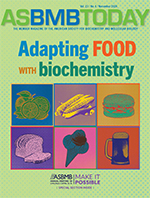 November
November